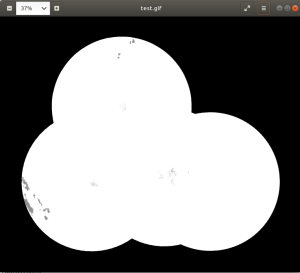Tools for handling radar files
On Windows or Mac find a HDF5 viewer here :
https://www.hdfgroup.org/downloads/hdfview/?1638350659 (external site)
The HDF viewer is, in the example, loaded with a volume, pseudo CAPPI and composite radar file:

On Linux find a lot of tools here:
https://portal.hdfgroup.org/downloads/index.html (external site)
After installing them here:
https://www.howtoinstall.me/ubuntu/18-04/hdf5-tools/ (external site)
Then you can inspect the files with the "h5dump" command.
(Note what is meta data and what is actual data and note, that the metadata tells where the path to the actual data is, say "dataset1/data1/data")
$ h5dump dk.com.202108090355.500_max.h5
HDF5 "dk.com.202108090355.500_max.h5" {
GROUP "/" {
ATTRIBUTE "Conventions" {
DATATYPE H5T_STRING {
STRSIZE 12;
STRPAD H5T_STR_NULLPAD;
CSET H5T_CSET_ASCII;
CTYPE H5T_C_S1;
}
DATASPACE SCALAR
DATA {
(0): "ODIM_H5/V2_0"
}
}
GROUP "dataset1" {
GROUP "data1" {
ATTRIBUTE "quantity" {
DATATYPE H5T_STRING {
STRSIZE 4;
STRPAD H5T_STR_NULLPAD;
CSET H5T_CSET_ASCII;
CTYPE H5T_C_S1;
}
DATASPACE SCALAR
DATA {
(0): "DBZH"
}
}
DATASET "data" {
DATATYPE H5T_STD_U8LE
DATASPACE SIMPLE { ( 1728, 1984 ) / ( 1728, 1984 ) }
DATA {
(0,0): 255, 255, 255, 255, 255, 255, 255, 255, 255, 255, 255,
(0,11): 255, 255, 255, 255, 255, 255, 255, 255, 255, 255, 255,
(0,22): 255, 255, 255, 255, 255, 255, 255, 255, 255, 255, 255,
(0,33): 255, 255, 255, 255, 255, 255, 255, 255, 255, 255, 255,
(0,44): 255, 255, 255, 255, 255, 255, 255, 255, 255, 255, 255,
(0,55): 255, 255, 255, 255, 255, 255, 255, 255, 255, 255, 255,
(0,66): 255, 255, 255, 255, 255, 255, 255, 255, 255, 255, 255,
(0,77): 255, 255, 255, 255, 255, 255, 255, 255, 255, 255, 255,
(0,88): 255, 255, 255, 255, 255, 255, 255, 255, 255, 255, 255,
(0,99): 255, 255, 255, 255, 255, 255, 255, 255, 255, 255, 255,
(0,110): 255, 255, 255, 255, 255, 255, 255, 255, 255, 255, 255,
(0,121): 255, 255, 255, 255, 255, 255, 255, 255, 255, 255, 255,
(0,132): 255, 255, 255, 255, 255, 255, 255, 255, 255, 255, 255,
(0,143): 255, 255, 255, 255, 255, 255, 255, 255, 255, 255, 255,
(0,154): 255, 255, 255, 255, 255, 255, 255, 255, 255, 255, 255,
(0,165): 255, 255, 255, 255, 255, 255, 255, 255, 255, 255, 255,
:
With this information you can try to use the h52gif tool, which converts a h5 file downloaded from the API to a gif file:
| $ h52gif dk.com.202108060720.500_max.h5 test.gif -i dataset1/data1/data |
Afterwards you have an image in the gif format:

This is a only a very tiny bit of what you can do, explore for yourself and have fun !





